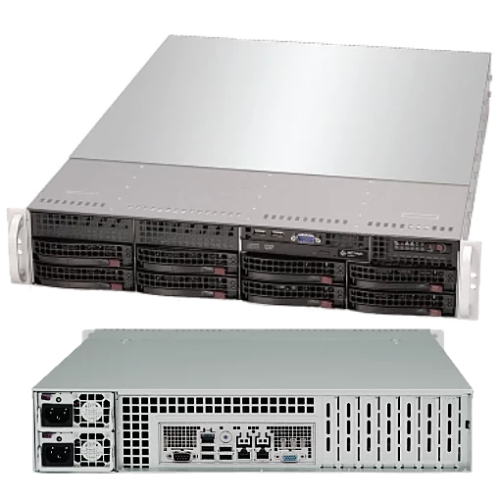
ETERIO 127 RE1
High-performance yet cost-effective 2U rack-mounted chassis for new application areas—where a single powerful processor with ample resources (cores, PCI Express lanes, and memory support) is sufficient. The eterio 127 RE1 server uses the new AMD EPYC server processor family. The platform features 8 RAM slots and allows for the use of either 8 standard 3.5″ drives or 16 standard 2.5″ drives (including up to 6 NVMe U.2 drives), or 24 2.5″ drives (SFF SAS/SATA or NVMe U.2), depending on the chassis configuration. It offers 6 low-profile PCIe slots and a dedicated M.2 PCIe x4 slot—supporting, for example, NVMe SSDs. Some chassis versions come with a single power supply, but most are equipped with a redundant power supply set.
Specifications
| Chassis | RACK 2U; 8 Hot-Swap 3.5″ Drives Bays: 8 x 3.5″ (HDD SAS/SATA hot-swap) 1 x slim drive (DVD or DVD-RW) 3 x 8-cm hot-swap fans Optional front ports: 2 x USB, 1 x RS-232 Power supply: redundant 2 x 800W (80PLUS Titanium) or redundant 2 x 1000W (80PLUS Titanium) RACK 2U; 12 Hot-Swap 3.5″ Drives Bays: 12 x 3.5″ (HDD SAS/SATA hot-swap) 3 x 8-cm hot-swap fans Optional mounting module: For 2 additional 2.5″ hot-swap drives Power supply: redundant 920W (80PLUS Platinum), or optionally redundant 2 x 1200W (80PLUS Titanium) RACK 2U; 16 Hot-Swap 2.5″ Drives Bays: 16 x 2.5″ (HDD SAS/SATA hot-swap, including optionally up to 6 x NVMe U.2) Optional slim drive: (DVD or DVD-RW) 3 x 8-cm hot-swap fans Optional front ports: 2 x USB, 1 x RS-232 Power supply: redundant 2 x 1200W (80PLUS Titanium) RACK 2U; 24 Hot-Swap 2.5″ Drives Bays: 24 x 2.5″ (NVMe U.2) 3 x 8-cm hot-swap fans Power Supply: redundant 2 x 1200W (80PLUS Titanium) |
| Processor | AMD Epyc 7001/7002 series |
| Memory slots | 8 |
| Maximum number of processors | 1 |
| Memory type | DDR4 Registered ECC, DDR4 3DS LRDIMM |
| Maximum supported memory | 2 TB / 1 TB |
| Available memory module sizes | 16 GB
32 GB 64 GB 128 GB |
| Memory protection mechanism | ECC |
| Integrated controllers | SATA3 16 ports
M.2 PCIe x4 (in 2280, 22110 format) |
| Expansion slots | 3 x PCIe 3.0 x16 (LP)
3 x PCIe 3.0 x8 (LP) 1 x M.2 (22110, 2280), PCIe x4 – for SSD NVMe disks |
| I/O ports | 1 x VGA
2 x LAN (RJ45) 1 x LAN (RJ45) – Dedicated for management USB: – 2 x Rear USB 3.0 – 2 x Rear USB 3.0 – Optional: 2 x Front USB 2.0 or 3.0 (excluding cases where this is not possible, such as with 12 x 3.5″ or 24 x 2.5″) – 1 x Internal (Type A, USB 3.0) |
| Management | SuperDoctor 5
IPMI 2.0 Optional Software: Supermicro Power Manager (SPM) Supermicro Update Manager (SUM) Supermicro Server Manager (SSM) Built-in support for “Remote KVM” and “Media redirection” |
| Supported operating systems | Red Hat Enterprise Linux Server 7.x, 8.x
SUSE Linux Enterprise Server 12, 15 (64-bit) Microsoft Windows Server 2016 Microsoft Windows Server 2019 VMware ESXi 6.x XenServer 7.x Ubuntu LTS CentOS |
| Notes | There are three versions of the motherboard available: with/without SAS controller or NVMe ports |
| Intelligent power management | YES |
| Additional information | To support NVMe drives in the chassis with 24 NVMe U.2 disks, dedicated expansion cards are required, which will reduce the available PCIe slots. Dedicated cable management arms or physical blockers can be installed in the chassis to restrict physical access to the drives. |
| Integrated graphics card | BMC integrated Aspeed AST2500 |
| Integrated network card | 2 x Gigabit Ethernet, RJ-45 (based on Intel i210) |
| Chassis form factor | RACK 2U |
| Certified operating systems | Windows Server 2016
Windows Server 2019 |
| TPM | Slot for TPM 1.2/2.0 module |